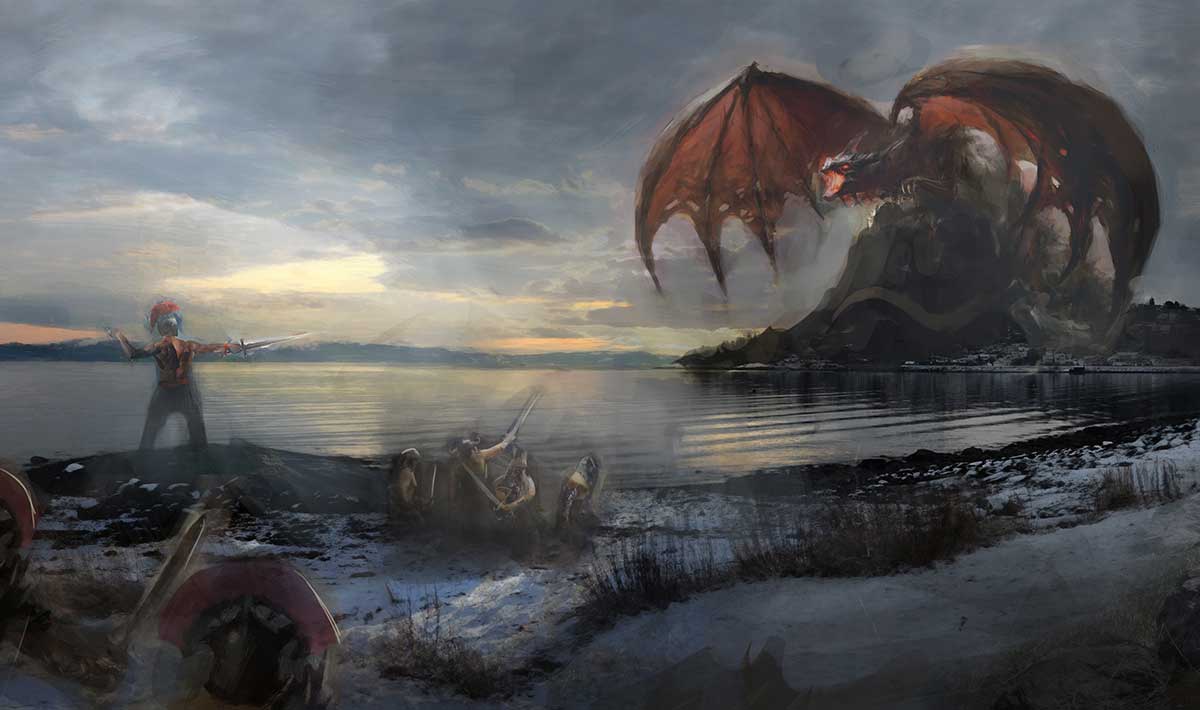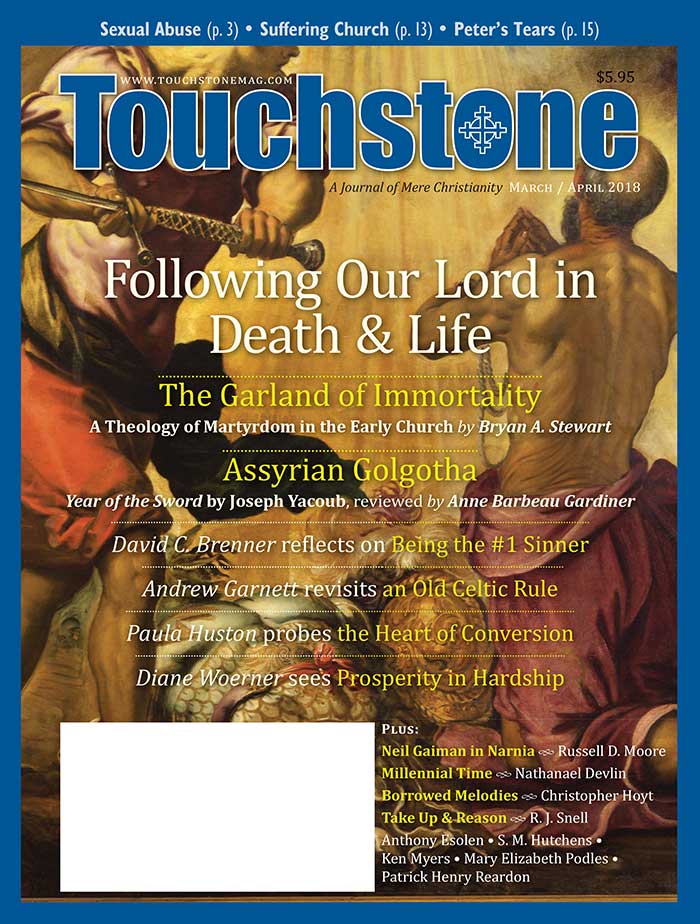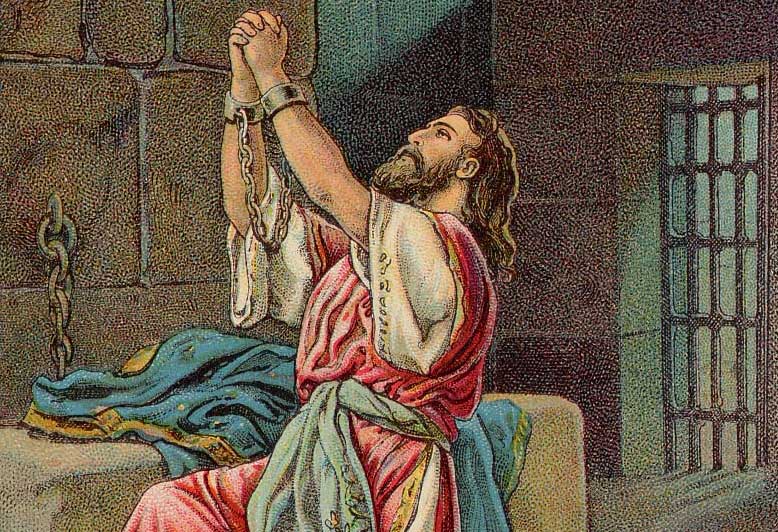Feature
Watchful Dragons
Neil Gaiman’s Brush with Narnia Lingers
by Russell D. Moore
Last year, Neil Gaiman published his long-awaited work, Norse Mythology, a collection of the ancient stories of the Nordic gods. This is not a translation, but a retelling. As Eugene Peterson’s The Message is to the Bible, Gaiman’s Norse Mythology is to Norse mythology. The book was widely anticipated not so much because it collects mythic tales as because of the author himself. For many of his readers, Gaiman awakened an interest in the old gods in the first place. And for Gaiman himself, something of this longing for Valhalla started in the wardrobe of a spare room.
At first glance, Gaiman would seem to be of little interest to those Christians who are unfamiliar with his work. Why should they pay attention to him any more than they would to the latest young adult werewolf romance? Gaiman is important, though, because he is not just a bubble on the surface of popular culture but a tidal current within it. We also should give him some attention because he is raising the sorts of questions we will want raised if we are to bear witness to Christian orthodoxy in a “post-Christian” Western culture.
At the risk of being hyperbolic, one could say that to understand Neil Gaiman is to understand pop culture, and by pop culture I mean virtually all of it. For decades, readers have known him for his best-selling fantasy and science fiction novels, such as American Gods and The Ocean at the End of the Lane. Children (and their parents) know him as the author of the book upon which the (very creepy) animated film Coraline was based, and for his children’s books, such as The Graveyard Book and Crazy Hair. Comic book fans know him as the author of a wide range of comics, from issues of Batman to his award-winning series of graphic novels, The Sandman. One might also know him for his short story collections or his non-fiction essays on everything from the craft of writing to music reviews of Tori Amos and Lou Reed.
His 2012 commencement speech “Make Good Art” went viral—first as a YouTube video and then as a graduation gift-book (seriously, how many graduation speeches does one want to hear the first time, much less over and over again? This one). With the release last year of his new volume retelling the classic tales of Norse mythology, and the serialization of his American Gods on a cable television network, Gaiman has planted his flag in that medium as well.
In fact, it would be hard to find a story-telling medium, with the possible exceptions of opera and hip-hop, where Gaiman isn’t somewhere at work—and who knows whether the new Gaiman aria or rap track will be issued by the time this article goes to print.
A Complicated Relationship
The connection between C. S. Lewis and Neil Gaiman isn’t as obvious as Gaiman’s imaginative debt to, say, Ray Bradbury. After all, Lewis is best remembered as a committed Christian apologist, while Gaiman is decidedly, well, not. But Gaiman is not anti-Lewis, like, say, Phillip Pullman, whose Golden Compass books set out to dethrone Aslan with a bleak, atheistic universe. Gaiman’s relationship to Lewis is more complicated.
Lewis and Gaiman have more in common than their United Kingdom accents and their United States fan bases. As children, though from two different generations of the twentieth century, both had their imaginations lit up initially by popular culture artifacts—in Lewis’s case, Beatrix Potter’s Squirrel Nutkin; in Gaiman’s, Stan Lee’s The Mighty Thor. Both were drawn to Norse mythology and its sense of “Northernness,” including the death of Balder. And both were repelled by the church but drawn to Narnia.
Narnia, after all, was initially created to rescue a sense of the sacred from the established church and from what Inklings biographers Philip and Carol Zaleski describe as “the moralistic sentimentality by which it has been deadened” (The Fellowship: The Literary Lives of the Inklings, 2015, p. 390). This was why, Lewis concluded, he didn’t feel the weight of the stories of Scripture. They were too familiar to him.
“But suppose that by casting all these things into an imaginary world, stripping them of their stained glass and Sunday school associations, one could make them for the first time appear in their real potency?” Lewis wondered, in retrospect. “Could one not thus steal past those watchful dragons? I thought one could” (ibid.).
Gaiman remarked that Lewis did, in fact, steal past the watchful dragons of his imagination. When he discovered, later in childhood, that many parts of the stories he loved were rooted in Christian doctrine, he felt offended, and even betrayed, that “an author, whom I had trusted, had had a hidden agenda” (The View from the Cheap Seats: Selected Nonfiction, 2014, p. 34). And it wouldn’t be the last time he was offended by Narnia.
Gaiman was especially irked by the “problem of Susan,” Lewis’s characterization of the female character as “no longer a friend of Narnia” after she reached adolescence and became interested in “nothing nowadays except lipstick and nylons and invitations” (The Last Battle, 1956, p. 154). Gaiman struck back with a kind of sequel, a short story from the grown-up Susan’s point of view. While some objected to Lewis’s exile of Susan as evidence of his alleged misogyny, Gaiman focused more of his fire on theodicy.
Gaiman’s Susan reflects on the train accident that, in Lewis’s account, ushered the other Pevensie children into the ever-expanding Narnia-beyond-Narnia. In Gaiman’s rendering, Edmund was decapitated, and Susan was the only one who could identify the body. “A god who would punish me for liking nylons and parties by making me walk through that school dining room, with the flies, to identify Ed, well . . . he’s enjoying himself a bit too much, isn’t he?” she muses. “Like a cat, getting the last ounce of enjoyment out of a mouse” (Fragile Things: Short Fictions and Wonders, 2006, p. 187). Not a tame lion, indeed.
But even in warring against the Christ-figure of Narnia, Gaiman couldn’t completely quit him. Gaiman wrote that his story wasn’t so much a repudiation of The Last Battle as a lover’s quarrel with a book series he’d read hundreds of times as a child and then read aloud twice to his own children. He sought to write a story “that would be equally problematic, and just as much of an irritant, if from a different direction, and to talk about the remarkable power of children’s literature” (Fragile Things, p. xxv). The story wasn’t so much about whether a God who allows suffering is cruel as it was about how stories can embed themselves in the imagination, and change an entire life.
In fact, Gaiman confesses that Lewis is the one who made him want to be a writer in the first place. In Lewis’s casual prose, including his authorial asides in brackets, Gaiman found, as many of us have, someone “standing behind the words,” telling a story. The boy Gaiman read other books, “but in my heart I knew that I read them only because there wasn’t an infinite number of Narnia books to read” (Cheap Seats, pp. 34–35).
Stories That Seemed True
However much Gaiman dispenses with the Christian religion, Lewis did indeed “steal past the watchful dragons.” The same has been true for many others, before and since. But how did Lewis do this? It wasn’t his characters. As the other Inklings knew, Narnia wasn’t a carefully constructed mythic sub-creation, as Tolkien’s Middle Earth was. But for many of us, including Gaiman, there was something else at work in Aslan’s realm.
“The weird things about the Narnia books for me was that mostly they seemed true,” Gaiman reflected. “These were reports from a real place” (Laura Miller, The Magician’s Book: A Skeptic’s Adventure in Narnia, 2008, p. 23).
The ghost of Lewis persists in the art of Gaiman. “It’s all in Plato, all in Plato; bless me, what do they teach them in these schools,” said Digory Kirke in the Chronicles of Narnia (Last Battle, p. 195). There’s a fair share of Platonism in Gaiman’s work, too, but it might be more accurate to say of his work, “It’s also much in Jung,” or “It’s somewhere in Joseph Campbell.” This is especially true of American Gods, now seeing a comeback due to tie-ins with the television series.
The very things that irritated Tolkien about Narnia are also in Gaiman’s American Gods universe. Narnia didn’t maintain a consistent mythology—Father Christmas was right there along with centaurs and fauns. In American Gods, mythologies intersect with each other, and with contemporary culture. Odin of the Vikings teams up with deities from other pantheons, such as those of sub-Saharan Africans, Native Americans, and Egyptians. These deities live among us, as funeral directors and steelworkers and prostitutes. Right there in the mix is Lucy Ricardo (as in “I Love”) and a whole panoply of faces and names not ordinarily found together.
In the American Gods mythology, the old gods—the supernatural beings associated with rain and fertility and war—are at odds with the new gods—such as media and technology. Many of the motifs of Narnia are there. The “bad guys” muster their troops at the Stone Table in Lewis’s Narnia; they do so at Chattanooga’s Rock City in Gaiman’s America. The Pevensie children find their destiny as kings and queens of Narnia; Gaiman’s human Shadow Moon (yes, that’s his name) finds his destiny as, literally, the son of a god. Aslan offers up his life as an atoning sacrifice in Narnia; Odin does the same for Gaiman, complete with a spear in his side and, of course, a resurrection.
Gaiman would say that he is simply working with the myths as he found them. As he retells the story in his recent collection of Norse myths, Odin does indeed climb the world tree and hang himself in self-sacrifice, “making the world-tree a gallows and himself the gallows god.” For Gaiman, the gospel might well simply be an echo of that archetypal story. One god with the gallows, another with the cross. But, of course, that is precisely what initially repelled Lewis from Christianity, and ultimately drew him to it.
A conversation with a “hard-boiled atheist” about the myth of the dying god is, after all, what shook the spiritually adrift Lewis into considering Christianity. The question, for him, was why so many signs were planted in the world’s myths and where they would find their maturity. He concluded that the latter could only be in Hinduism or Christianity, and, being trained in literary criticism, he concluded that the gospel accounts did not have a “mythical taste” but a historical one. Of the gospel, Lewis came to believe, “If ever a myth had become fact, had been incarnated, it would be just like this” (Surprised by Joy: The Shape of My Early Life, 1955, pp. 235–236).
Old Paganism Meets New Secularism
This is where Gaiman departs from Lewis in important ways. For Lewis, the children learn to see past Enlightenment naturalism to the possibility that there’s a world beyond the wardrobe, a world to which they may journey but that exists independently of them (ask poor Susan). Aslan may condescend to the sons of Adam and the daughters of Eve, but he does not need them. The gods of Gaiman’s world are, compared to the regal Lion, pathetic figures. Their power, indeed their very existence, is derived from human attention and worship.
This theme transcends American Gods, showing up in the Sandman graphic novel series as well. Goddesses who once were fed power through temple prostitution now vie for attention as strippers in seedy, roadside joints. The Egyptian cat goddess Bast languishes in her crumbling temple. “She remembers when the prayers and offerings swarmed around her at all times, uncountable, when she would pick and choose between them, selecting prayers on merit or on whim, accepting or rejecting offerings” (The Sandman, Volume 7: Brief Lives, 1992).
It’s here that old paganism meets the new secularism. On the one hand, the sacrifices needed to fuel the attention of the gods are quite ancient (think Baal and Moloch as well as Zeus and Ra). On the other, here is also the thoroughly modern concept of the divine as a projection of human aspirations for transcendence. For Gaiman, the very old, scary, violent world of polytheism merges with the bleak, disenchanted world of progressive secularization.
Thus, in American Gods, Wednesday, Gaiman’s re-imagination of Odin, tells his traveling companion across the American landscape, Shadow, that roadside attractions are places of power, a channel to the Immanent, in a way that temples or cathedrals once were. When Shadow remarks that there still are churches all over America, Odin dismisses them as being no more significant than dentists’ offices. In roadside attractions, though, human persons “felt themselves being pulled to places where, in other parts of the world, they would recognize that part of themselves that is truly transcendent, and buy a hot dog and walk around, feeling satisfied on a level they cannot truly describe, and profoundly dissatisfied on a level beneath that” (American Gods: Author’s Preferred Text, 2011, p. 106).
In Gaiman’s America, the new gods taunt the old with the old gods’—that is, the supernatural’s—increasing irrelevance and impending demise. The personification of technology sends a message to Odin that the new gods are reprogramming reality; the paradigm is shifting and nothing else is important. This is because, he says, language is a virus, religion is an operating system, and prayers are nothing more than spam (American Gods, p. 50). The contest of the novel is whether people will continue to believe in the ghosts and gods they dream up to find meaning or whether they will discard these for the new, secular paradigm.
Lamenting a Loss
Gaiman is no triumphal secularist, no new atheist smiling toward Gomorrah. Quite the contrary. Even in his non-Christianity, Gaiman laments the loss of enchantment. The old gods may just be projections of human hopes and fears, but the new gods are even more vacuous, more disappointing, and arguably more dangerous. In this, Gaiman, perhaps unwittingly, agrees with Lewis.
Lewis argued that paganism was a better place to begin the search for meaning—and thus for the gospel—than was arid secularism. More importantly, Gaiman here, again unwittingly, agrees with Jesus, who saw in Mammon not just the impersonal reality of “money” but, as a personification, a god many worship, and to which many could become enslaved.
In his Norse Mythology,Gaiman notes that he has long been fascinated with Ragnarok, the mythical twilight of the gods, when the deities face a “last battle” and die. This is not, though, because Gaiman rejoices in the idea of seeing the divine gone. The fact that the contemporary reader of these myths did not know whether he was living pre- or post-Ragnarok was what made the story “linger” for him. Ragnarok gave the world a plot—a narrative beginning and end—that made the mythic world “seem strangely present and current, while other, better-documented systems of belief felt as if they were part of the past, old things” (Norse Mythology, p. 12).
At some level, Gaiman wants there to be a plot to the universe, and perhaps to his own life. And at some level, he seems to fear what is left if there is not. “Ask me with a gun to my head if I believe in them, all the gods and myths that I write about, and I’d have to say no. Not literally,” he writes. “Not in the daylight, nor in well-lighted places, with people about” (Cheap Seats, p. 63). Of course, Gaiman will not always be in well-lighted places; none of us will. The question is whether there is something, or Someone, waiting for us in the dark—someone who has placed for us what Lewis and Walker Percy call “signposts” along the way, in our stories, in our histories, in our life-plots.
In The Sandman series, the protagonist is not a god; he predates the gods. Morpheus or Sandman or Dream (he goes by many names) is one of “The Endless,” beings who have been about since the dawn of the universe. These beings—such as dream and despair and destruction and delirium—seem personal and active. But in the storyline, the Endless named Destruction claims that the Endless aren’t, in fact, real but are merely mythic patterns, ideas, wave functions, repeating motifs, echoes of darkness. As Peter Straub sums up in his afterword to volume seven in the series, “The only one of them to survive this epoch in the ongoing story of the universe will be Death, who existed before life began” (“On Mortality and Change,” in Gaiman, Sandman, vol. 7).
Gaiman’s universe features a last enemy, a last word: death. The question is whether, as the Apostle John bears witness, there is a Word before that, and, as the Apostle Paul testifies, there is a Word after that. Lewis believed there is, and Gaiman, even in his gloomy Ragnarokian universe, sometimes seems to hope there is.
Perhaps, as I believe, this longing is part of the human condition, an awareness of the divine that we must repress in order to deny (Rom. 1:19–23; 2:14–16). In Gaiman’s case, perhaps this art-expressed longing is rooted in those stories he encountered as a child. “Sometimes fiction is a way of coping with the poison of the world in a way that lets us survive it,” he recounts. “And I remembered. I would not be the person I am without the authors who made me what
I am—the special ones, the wise ones, sometimes just the ones who got there first.”
“It’s not irrelevant, those moments of connection, those places where fiction saves your life,” Gaiman continues. “It’s the most important thing there is.” Indeed, it is. And perhaps there is more yet of Neil Gaiman left to be saved.
The Hidden Agenda That Wasn’t
Neil Gaiman’s story is the story of many in our disenchanted, disappointed era. In order to address them, we must learn, like Lewis, to speak to the imagination with a word that provokes longing and joy. “A story is a good way of gettin’ someone on your side,” the African deity Anansi (“Mr. Nancy”) says in American Gods. That’s not necessarily true. But a story is a good way to be heard, to speak to the psyche and the conscience, to subliminal hopes and fears.
That’s why Lewis resonated with Gaiman—and with me. In the Narnia tales, Lewis had nothing to sell. He simply had a story that was itself embedded in a Story he had the confidence to believe was true. In an era when many suspect that religion—and the Christian religion in particular—is just a vehicle for political or economic power (and when many have, sadly, been given many reasons to think so), this sort of conscience-to-conscience truth-telling is necessary.
That’s why the “hidden dragons” had to be sneaked past. In the Christianized West, the gospel story has too often been presented as a means to an end—to moral behavior or to patriotism or to a place among the “normal people” of the culture. That is a Screwtape religion, not a Narnian one. When the gospel message is heard in unexpected places, in unexpected ways, one can hear something that is far from “normal,” far from a means to some earthly end.
Gaiman may have resented Lewis’s “hidden agenda” when he discovered it; many do. But how liberating it is to find out that Lewis’s hidden agenda is actually the agenda—there is no agenda behind it. Lewis had found Joy, had found Aslan’s country, and simply said to the reader, “Come and see.” The old gods disappoint, and the new ones do, too. But there’s another Story yet.
The work of Neil Gaiman is one more reminder that however transcendence-averse modern cerebra might be, the message has not reached the modern imagination. Even in the sterilized secularity of the West, there are yet signposts in a strange land. There are yet intimations of interest in something, or someone, just out of reach, even when those intimations are safely hidden away in science fiction or fantasy. Christians should take note. Perhaps the way to speak to a transcendence-starved West might include not only a cathedral liturgy or a revival tent, but also, even still, a lion, a witch, and a doorway, just where one least expects it, to Narnia.
Russell D. Moore is president of the Ethics and Religious Liberty Commission of the Southern Baptist Convention. He is a senior editor of Touchstone.
subscription options
Order
Print/Online Subscription

Get six issues (one year) of Touchstone PLUS full online access including pdf downloads for only $39.95. That's only $3.34 per month!
Order
Online Only
Subscription

Get a one-year full-access subscription to the Touchstone online archives for only $19.95. That's only $1.66 per month!
bulk subscriptions
Order Touchstone subscriptions in bulk and save $10 per sub! Each subscription includes 6 issues of Touchstone plus full online access to touchstonemag.com—including archives, videos, and pdf downloads of recent issues for only $29.95 each! Great for churches or study groups.
Transactions will be processed on a secure server.
more on C. S. Lewis from the online archives
more from the online archives
calling all readers
Please Donate
"There are magazines worth reading but few worth saving . . . Touchstone is just such a magazine."
—Alice von Hildebrand
"Here we do not concede one square millimeter of territory to falsehood, folly, contemporary sentimentality, or fashion. We speak the truth, and let God be our judge. . . . Touchstone is the one committedly Christian conservative journal."
—Anthony Esolen, Touchstone senior editor












